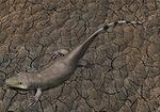
Tseajaia
Encyclopedia
Tseajaia is an extinct genus
of tetrapod
. It was an anthracosauria
n that lived in the Permian
of North America
. The skeleton is that of a medium sized, rather advanced reptile-like amphibian. In life it was about a meter (3 ft.) long and may have looked vaguely like an iguana
, though slower and and with a more amphibian foot without claw
s. The dentition was somewhat blunt, indicating herbivory or possibly omnivory.
. It was originally thought to be an seymouriamaorph
. Additional finds allowing for a better taxonomic analysis indicate they belong in the Diadectomorpha
, as the sister group to the large and more derived Diadectidae
. Tseajaia itself being a fairly generalized form, gives a reasonable indication of the build and looks of the closest relatives of the amniote
s.
Genus
In biology, a genus is a low-level taxonomic rank used in the biological classification of living and fossil organisms, which is an example of definition by genus and differentia...
of tetrapod
Tetrapod
Tetrapods are vertebrate animals having four limbs. Amphibians, reptiles, birds and mammals are all tetrapods; even snakes and other limbless reptiles and amphibians are tetrapods by descent. The earliest tetrapods evolved from the lobe-finned fishes in the Devonian...
. It was an anthracosauria
Anthracosauria
Anthracosauria is an order of extinct reptile-like amphibians that flourished during the Carboniferous and early Permian periods, although precisely which species are included depends on one's definition of the taxon.-Various definitions:...
n that lived in the Permian
Permian
The PermianThe term "Permian" was introduced into geology in 1841 by Sir Sir R. I. Murchison, president of the Geological Society of London, who identified typical strata in extensive Russian explorations undertaken with Edouard de Verneuil; Murchison asserted in 1841 that he named his "Permian...
of North America
North America
North America is a continent wholly within the Northern Hemisphere and almost wholly within the Western Hemisphere. It is also considered a northern subcontinent of the Americas...
. The skeleton is that of a medium sized, rather advanced reptile-like amphibian. In life it was about a meter (3 ft.) long and may have looked vaguely like an iguana
Iguanidae
Iguanidae is a family of lizards, composed of iguanas and related species.-Classification of Iguanidae:Two different classification schemes have been used to define the structure of this family. These are the "traditional" classification and the classification presented by Frost et al. .Frost et...
, though slower and and with a more amphibian foot without claw
Claw
A claw is a curved, pointed appendage, found at the end of a toe or finger in most mammals, birds, and some reptiles. However, the word "claw" is also often used in reference to an invertebrate. Somewhat similar fine hooked structures are found in arthropods such as beetles and spiders, at the end...
s. The dentition was somewhat blunt, indicating herbivory or possibly omnivory.
Phylogeny
Tseajaia was described from a single, fairly complete specimen and was given its own family by Robert L. CarrollRobert L. Carroll
Robert Lynn Carroll is a vertebrate paleontologist who specialises in Paleozoic and Mesozoic amphibians and reptiles.Carroll was an only child and grew up on a farm near Lansing, Michigan...
. It was originally thought to be an seymouriamaorph
Seymouriamorpha
Seymouriamorpha were a small but widespread group of reptiliomorphs. Many seymouriamorphs were terrestrial or semi-aquatic. However, aquatic larvae bearing external gills and grooves from the lateral line system has been found, making them unquestionably amphibians. The adults were terrestrial...
. Additional finds allowing for a better taxonomic analysis indicate they belong in the Diadectomorpha
Diadectomorpha
Diadectomorpha are a clade of large reptile-like amphibians that lived in Euramerica during the Carboniferous and Early Permian periods, and are very close to the ancestry of the Amniota. They include both large carnivorous and even larger herbivorous forms, some semi-aquatic and others fully...
, as the sister group to the large and more derived Diadectidae
Diadectidae
Diadectidae is an extinct family of large diadectomorph reptiliomorphs. Diadectids lived in North America and Europe during the Late Carboniferous and Early Permian. They were the first herbivorous tetrapods, and also the first fully terrestrial animals to attain large sizes. Footprints indicate...
. Tseajaia itself being a fairly generalized form, gives a reasonable indication of the build and looks of the closest relatives of the amniote
Amniote
The amniotes are a group of tetrapods that have a terrestrially adapted egg. They include synapsids and sauropsids , as well as their fossil ancestors. Amniote embryos, whether laid as eggs or carried by the female, are protected and aided by several extensive membranes...
s.
External links
- Tseajaia in the Paleobiology DatabasePaleobiology Database' is an online resource for information on the distribution and classification of fossil animals, plants, and microorganisms.-History:The Paleobiology Database was founded in 2000. It has been funded by the National Science Foundation and the Australian Research Council...

